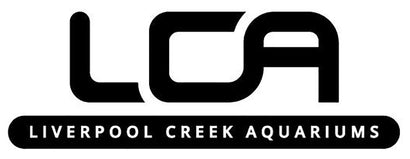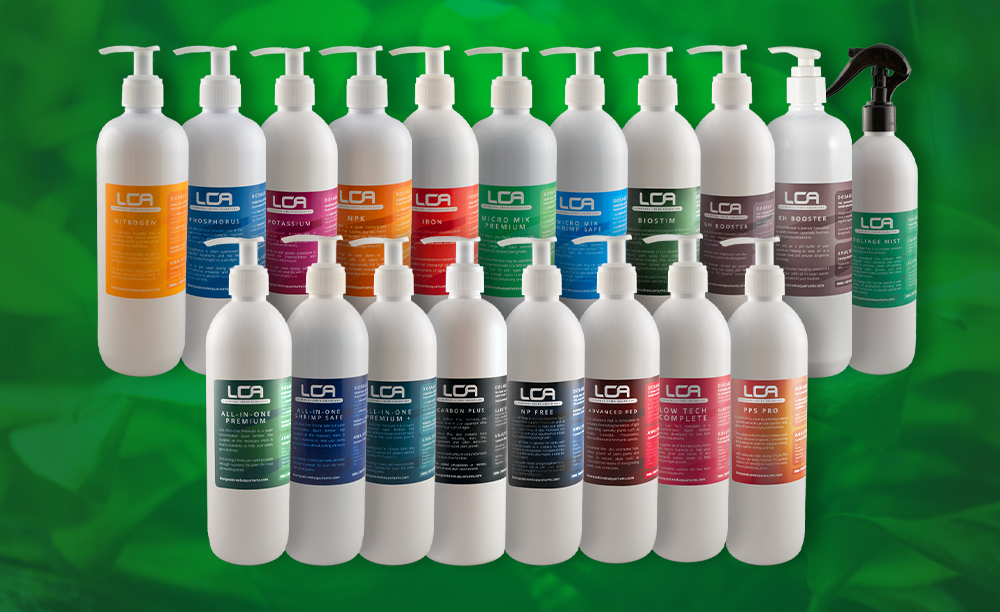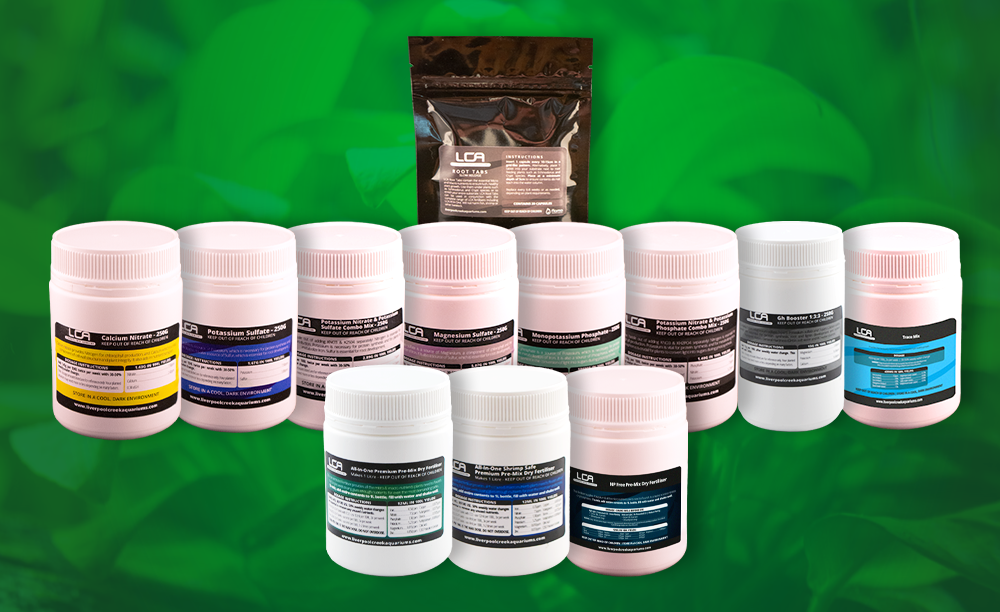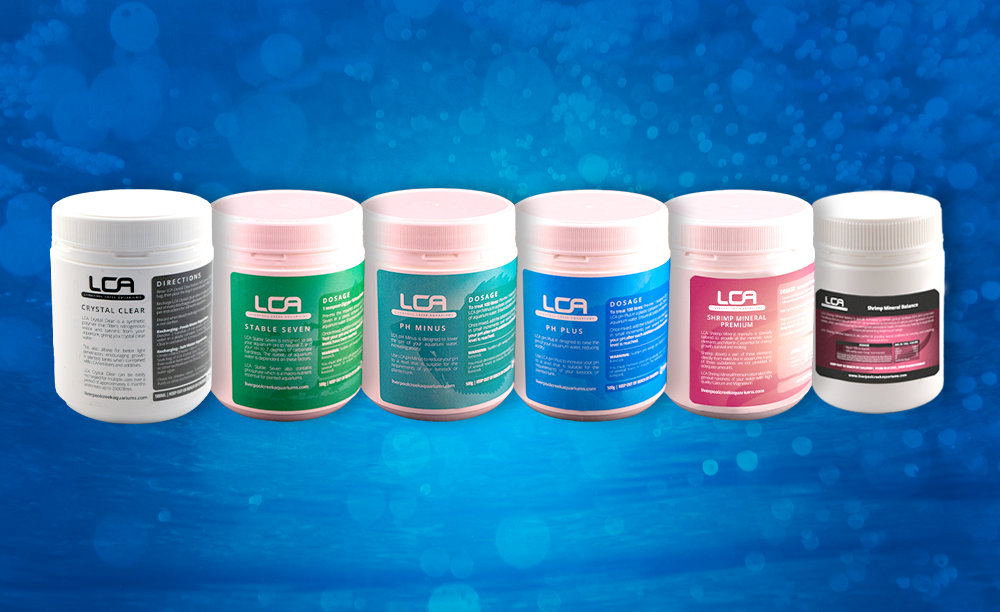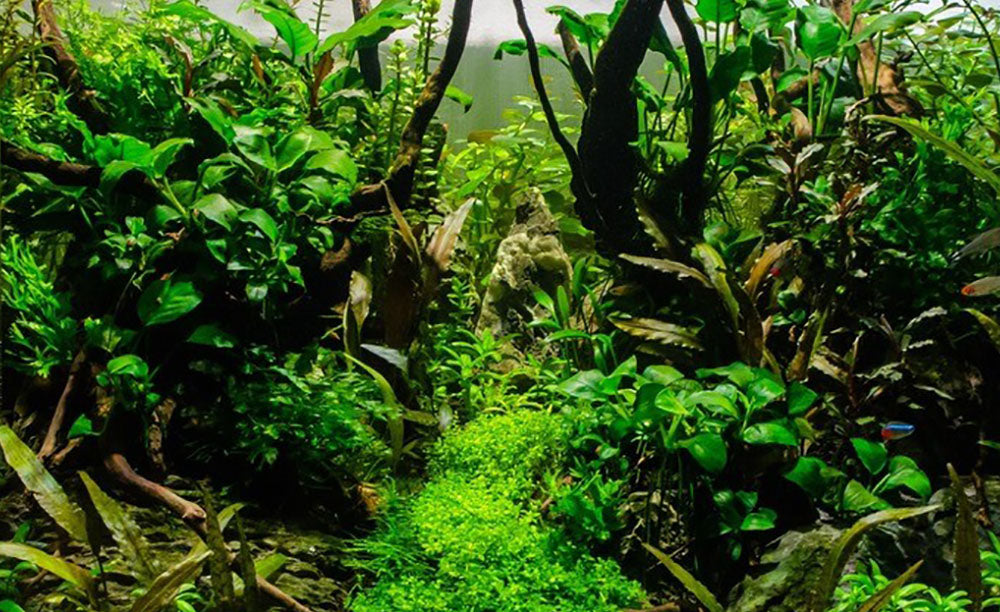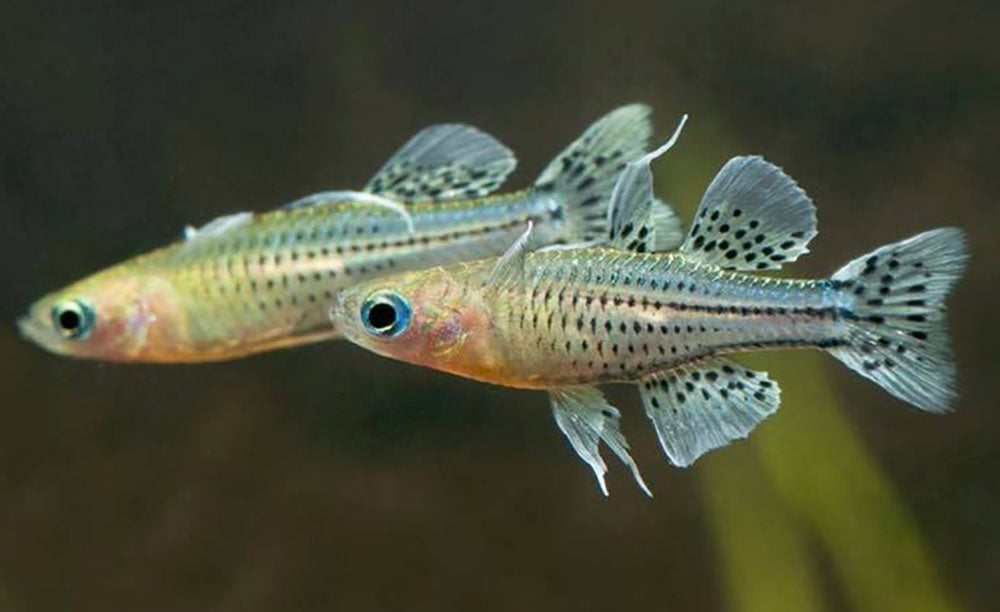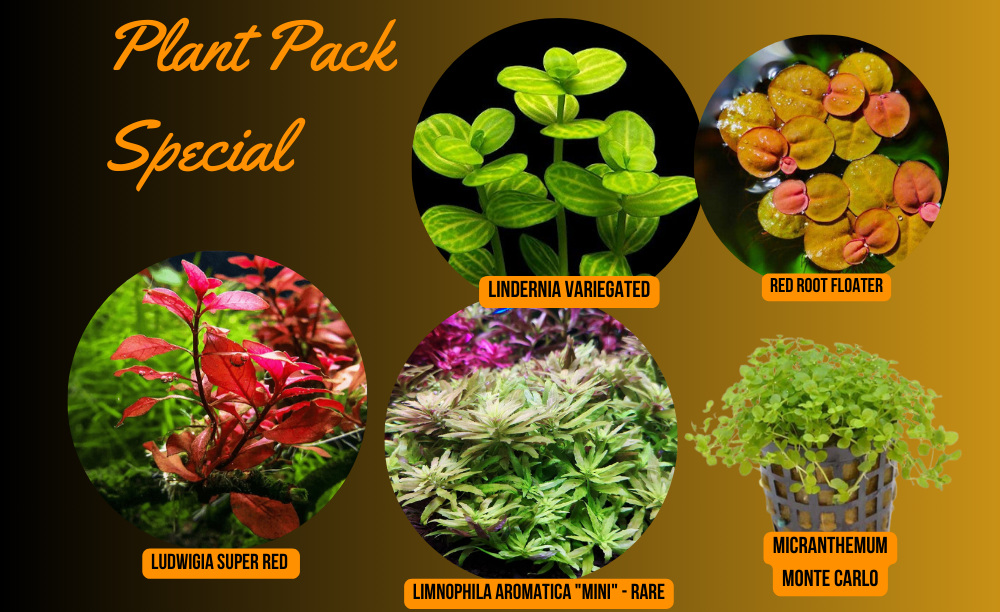Your Cart is Empty
BOXING DAY SALE 40% 0FF
***FREE SHIPPING ON ORDERS OVER $200***
ORDERS WILL BE SENT FROM JANUARY 12TH
BOXING DAY SALE 40% 0FF
***FREE SHIPPING ON ORDERS OVER $200***
ORDERS WILL BE SENT FROM JANUARY 12TH
Store
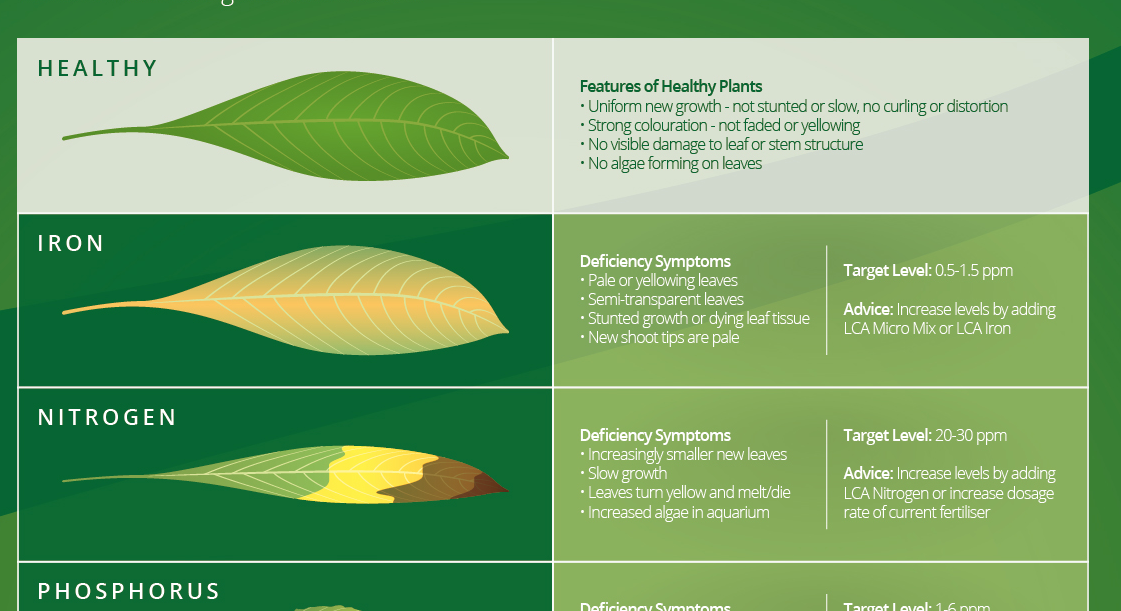
Are My Plants Deficient?
8 min read
Are My Plants Deficient?
The plants in your aquarium need a supply of both macro and micro nutrients to grow lush and healthy. Without sufficient levels of these nutrients and a host of other considerations, plants will deteriorate. But how can you tell what nutrients you are lacking?
Let’s first have a look at the most important nutrients in planted aquariums so we can understand the roles they play, before examining the best methods for diagnosing issues.
Important Macronutrients
Carbon – Carbon is used by plants at a much greater level than Nitrogen, more than 20 times by mass. It is the most important macro nutrient but is often in low supply in the home aquarium which limits growth rates, even with sufficient levels of other nutrients present. However, with injection of pressurised CO2, growth becomes limited only by the presence of other nutrients and light. CO2 deficiency should be considered as the first point of call before investigating any other lack of nutrients.
Nitrogen - This macronutrient is used in huge amounts by plants and if your tank is deficient in it you will definitely notice. Without sufficient nitrogen, plant growth will slow to a crawl or stop completely and your plants will start to turn yellow and pretty quickly start to melt away. You may also notice algae taking over. Limitation of nitrogen can be helpful for enhancing red colouration in some plant species but must be undertaken with care, with the addition of an enriched substrate highly recommended.
Phosphorus - Another macronutrient used in large amounts, Phosphorus is a crucial element in plant photosynthesis as well as cell structures. Without sufficient levels of Phosphorus, new growth will be smaller, leaves will become darker and you will notice more algae in your aquarium, particularly Green Spot Algae (GSA).
Let’s first have a look at the most important nutrients in planted aquariums so we can understand the roles they play, before examining the best methods for diagnosing issues.
Important Macronutrients
Carbon – Carbon is used by plants at a much greater level than Nitrogen, more than 20 times by mass. It is the most important macro nutrient but is often in low supply in the home aquarium which limits growth rates, even with sufficient levels of other nutrients present. However, with injection of pressurised CO2, growth becomes limited only by the presence of other nutrients and light. CO2 deficiency should be considered as the first point of call before investigating any other lack of nutrients.
Nitrogen - This macronutrient is used in huge amounts by plants and if your tank is deficient in it you will definitely notice. Without sufficient nitrogen, plant growth will slow to a crawl or stop completely and your plants will start to turn yellow and pretty quickly start to melt away. You may also notice algae taking over. Limitation of nitrogen can be helpful for enhancing red colouration in some plant species but must be undertaken with care, with the addition of an enriched substrate highly recommended.
Phosphorus - Another macronutrient used in large amounts, Phosphorus is a crucial element in plant photosynthesis as well as cell structures. Without sufficient levels of Phosphorus, new growth will be smaller, leaves will become darker and you will notice more algae in your aquarium, particularly Green Spot Algae (GSA).
Potassium - Potassium is a highly mobile macronutrient used in large amounts for photosynthesis and protein synthesis. Being highly mobile, this means plants are able to move it to new growth areas easily, so if you have a Potassium deficiency it will show up first in old growth. Typically it presents as leaf pinholes, yellowing and overall weakening of leaf structure.
Magnesium - A very important macronutrient which is often overlooked, Magnesium plays a vital role in photosynthesis as it comprises part of chlorophyll molecules in plants. It also works to activate plant enzymes that form oils, fats and starch. A deficiency in Magnesium presents in older leaves that will become pale or start yellowing, with brown spots developing on them as well. New leaf growth will be distorted or curled.
Calcium - Calcium is an essential macronutrient for healthy leaf and stem growth, affecting cell wall structure, plant integrity and nutrient transport. It’s usually available in sufficient amounts in aquariums without needing to add extra, unless your water source is soft or you are using reverse osmosis water. If your aquarium is deficient in Calcium, new leaves will become heavily distorted and twisted with leaf edges becoming yellow. Overall plant structure will be affected.
Important Micronutrients
Manganese/Zinc – Although not required in large amounts, this micronutrient still plays an important role in photosynthesis. Insufficient levels of Manganese and Zinc will affect photosynthesis, which in turn will slow plant growth as the plant reduces nutrient intake. It may also cause leaves to become pale with darker veins, and leaf texture may also become raised/rough, with patches of yellow. Leaf shape can become curled but lack of other nutrients can also contribute to this.
Iron - Iron is an essential micronutrient used by plants in the largest amount out of all micronutrients. In plants, Iron is used to transfer the energy created from photosynthesis throughout the entire plant structure. It is also vital for chlorophyll production. When Iron is deficient, growth will be stunted from lack of energy transfer and leaves will become pale due to absence of chlorophyll.
Other Micronutrients - There are a host of other micronutrients that are essential for plant growth, but are used in much smaller amounts than Manganese and Iron. Elements such as boron, copper, molybdenum, sulphur, oxygen and hydrogen are all used by aquatic plants for processes such as photosynthesis and chlorophyll production, in the development of leaf and stem structure, for the transfer of nutrients, energy and other compounds as well as root development.
Micronutrient deficiencies can lead to a host of problems directly affecting plant growth, including stunted or misshapen leaves and discoloured, withering or dying leaves, stems and even entire plants.
Determining Deficiencies
The LCA Plant Deficiency Guide can be a helpful tool for diagnosing deficiencies in your planted aquarium, but should not be the only means you use when plants start to look unwell. That’s because there is overlap between deficiency symptoms – for example, insufficient CO2, magnesium or iron will all result in pale or yellowing leaves.
Nutrients also work hand-in-hand in planted aquariums. For example, Phosphorus, Potassium and Magnesium all aid the photosynthesis process, and the micronutrient Iron transfers the energy it creates. Without all of these nutrients available in sufficient amounts, the entire process starts to fail.
So to determine exactly what is going wrong in a planted aquarium, rather than trying to pinpoint a deficiency in a specific nutrient, you should take a whole-tank approach. Are you injecting enough CO2, what are your water parameters, is the tank mature, is it well-maintained, is the substrate providing nutrients, are your plants stressed, what is your fertilisation schedule – there are many reasons plants might not look their best!
Rule 1 – Fertilise Regularly to a Schedule
If you fertilise your planted tank to a regular schedule, with a good comprehensive liquid fertiliser, you will know the level of each nutrient you are dosing every week. It’s important to keep the routine of fertilising regular so that you are providing a stable, measureable amount of nutrients.
Testing your water at the end of each week for nutrient levels can be extremely helpful in diagnosing issues. As an example, if you have >20ppm of nitrates at the end of the week, but growth has stopped or plants are melting, you can be sure that nitrate deficiency is not the issue. Generally speaking, if you are regularly dosing your comprehensive fertiliser according to instructions and the volume/plant mass of your tank, you can rule out macro and micronutrient deficiencies.
Rule 2 – CO2
CO2 is used in huge amounts by aquatic plants, if it’s available. Lots of difficult plant species require it to grow healthily. Before other nutrients are measured as possible factors of poor plant growth, CO2 should be considered. Insufficient CO2 saturation or fluctuating levels will cause numerous issues and make it much more difficult to determine if any other deficiencies are present.
Drop checkers are not reliable tools for checking CO2 levels. Instead, measure PH before and during CO2 injection. Generally, a drop of 1 point indicates about 30+ppm of CO2.
Alternatively, more advanced hobbyists can observe plant growth. Insufficient CO2 can result in thin stems, brittle leaves, unhealthy lower stems, vertical growth in carpeting plants, leggy growth in stems, distorted new growth, and most importantly, new leaves that progressively decrease in size.
It can be difficult to fine-tune your CO2 injection but is one of the most important factors in keeping a planted tank at its best.
Rule 3 – Be Nice to your Plants
Even with all the best nutrients, CO2, lighting and substrate, if a plant is stressed it will never look its best and can easily be mistaken as suffering from a deficiency. So how do you avoid stressing your plants?
The most important aspect to consider is stability. Plants in your aquarium are always adapting to the surrounding conditions to ensure they can utilise the available nutrients, photosynthesise and grow properly. If you are frequently tweaking lighting, nutrient dosing, CO2 levels, etc – your plants will always be continuously stressed as they attempt to acclimatise. This can result in poor growth, melting leaves, algae and more.
Plant husbandry and placement should also be considered. Plants will need space to grow, so don’t plant them too close together or they may stunt, or block light from lower sections. Regular trimming and replanting of stem tops, with discarding of old portions, is essential for continued healthy growth.
Make sure your plants aren’t shading others and trim them if required.
Provide adequate lighting for the species you are keeping and check your water parameters (including GH/KH/PH) and water temperature are all within suitable ranges for the plants in your aquarium.
By practicing good plant maintenance and providing a stable environment, you can rule out plant stress as a contributor to poor appearance.
Rule 4 - Maintain Your Tank
Another big part of keeping your plants and entire tank healthy is in performing regular maintenance.
Weekly water changes should be performed in any fertilised aquarium, as it helps to reset nutrient levels back to a baseline, preventing buildup and potential plant toxicity. When levels of some micronutrient levels are too high, leaf colouration and form can be affected – just as with deficiency!
During your weekly water change, siphoning detritus from the substrate surface will help inhibit the growth of algae by keeping levels of dissolved organics low. Algae can affect plant growth by inhibiting photosynthesis and damaging older leaves.
Ensure your filtration is adequate for your tank and that circulation is evenly distributed throughout the aquarium. Proper circulation ensures nutrients are delivered to all areas of the tank. You can dose fertiliser in sufficient amounts for your aquarium, but if it’s not being dispersed evenly by your flow, some plants may show signs of deficiency – they’re just not getting the same amount as your other plants.
Diagnosing Through Your Plants
The best way to diagnose deficiencies in your planted aquarium is by examining all the plants in your tank. Don’t focus on just one or two, as some plants will be affected differently, as will fast and slow growing species.
What to Look For – New Growth
Stem plants are generally fast growing, so they make good indicators of any recent deficiencies or other changes. The size, colour and shape of new leaves on fast growing stems will appear different if a deficiency is present.
New leaves should be either larger or the same size as previous leaves if they are healthy. If not, examine your CO2 and macronutrient levels, particularly Phosphorus and Magnesium.
Colouration of your leaves should be uniform, with no yellowing, pale sections or pronounced leaf veins. If the colouration of your leaves is affected, immobile nutrients such as boron, calcium, copper, iron, manganese or sulfur could be deficient.
Leaves should be smooth and uniform in shape, with no distortion or curling. Insufficient CO2 can cause problems here so should be checked first, followed by considering if levels of magnesium, zinc, calcium, manganese, boron and molybdenum are sufficient.
What to Look For – Old Growth & Slow Growers
If old leaves are becoming pale or yellowing, including leaf veins, or if pinholes are developing, this can point to deficiencies in nitrates, potassium or phosphorus or insufficient/unstable CO2 injection.
If old leaves are pale, yellowing or developing browns spots, but veins remain green, this can signal a deficiency in Magnesium.
If new growth looks fine but old growth is rapidly deteriorating and melting, consider if you are providing a stable environment. Rapid shedding of old growth suggests a plant is attempting to acclimatise to new conditions. Your aquarium may need more time to mature, or you might need to stop adjusting parameters.
Slow growing plants are excellent indicators of long term conditions due to the long lifespan of their leaves and their ability to regenerate them if conditions are good. They should not be used to diagnose recent deficiencies.
If the oldest leaves of slow growing plants like Anubias or Bucephalandra appear healthy and are not regularly shedding, you can be sure your aquarium is not deficient in nutrients and that parameters are stable. If old leaves on these plants are still displaying signs of deficiency, such as yellowing, this indicates a long-term deficiency in your tank that will need to be addressed.
Fixing the Deficiency
If you have determined you are deficient in a particular macro or micronutrient, and have ruled out CO2 levels as a contributing factor, it might be time to adjust the amount of fertiliser you are dosing. Even if you dose to instructions, you should be taking your plant mass and their metabolism into account. A large amount of fast growing stems is going to need a lot more nutrients than a large amount of Anubias.
When adjusting levels of nutrients, make sure to keep your new fertilisation regime regular for 1-2 weeks in high-tech tanks and 4+ weeks in low-tech. Observe for changes in the new growth of all of your plants, and check for the tell-tale signs of deficiencies. Compare the new growth to the old – has it improved, or is it the same, or worse? If you adjust nutrient levels and growth remains the same or worsens, you may be overdosing and should consider other parameters that can affect plant growth such as lighting, temperature and hardness.
From The LCA Team
Every Solution For Your Aquarium.

Magnesium - A very important macronutrient which is often overlooked, Magnesium plays a vital role in photosynthesis as it comprises part of chlorophyll molecules in plants. It also works to activate plant enzymes that form oils, fats and starch. A deficiency in Magnesium presents in older leaves that will become pale or start yellowing, with brown spots developing on them as well. New leaf growth will be distorted or curled.
Calcium - Calcium is an essential macronutrient for healthy leaf and stem growth, affecting cell wall structure, plant integrity and nutrient transport. It’s usually available in sufficient amounts in aquariums without needing to add extra, unless your water source is soft or you are using reverse osmosis water. If your aquarium is deficient in Calcium, new leaves will become heavily distorted and twisted with leaf edges becoming yellow. Overall plant structure will be affected.
Important Micronutrients
Manganese/Zinc – Although not required in large amounts, this micronutrient still plays an important role in photosynthesis. Insufficient levels of Manganese and Zinc will affect photosynthesis, which in turn will slow plant growth as the plant reduces nutrient intake. It may also cause leaves to become pale with darker veins, and leaf texture may also become raised/rough, with patches of yellow. Leaf shape can become curled but lack of other nutrients can also contribute to this.
Iron - Iron is an essential micronutrient used by plants in the largest amount out of all micronutrients. In plants, Iron is used to transfer the energy created from photosynthesis throughout the entire plant structure. It is also vital for chlorophyll production. When Iron is deficient, growth will be stunted from lack of energy transfer and leaves will become pale due to absence of chlorophyll.
Other Micronutrients - There are a host of other micronutrients that are essential for plant growth, but are used in much smaller amounts than Manganese and Iron. Elements such as boron, copper, molybdenum, sulphur, oxygen and hydrogen are all used by aquatic plants for processes such as photosynthesis and chlorophyll production, in the development of leaf and stem structure, for the transfer of nutrients, energy and other compounds as well as root development.
Micronutrient deficiencies can lead to a host of problems directly affecting plant growth, including stunted or misshapen leaves and discoloured, withering or dying leaves, stems and even entire plants.
Determining Deficiencies
The LCA Plant Deficiency Guide can be a helpful tool for diagnosing deficiencies in your planted aquarium, but should not be the only means you use when plants start to look unwell. That’s because there is overlap between deficiency symptoms – for example, insufficient CO2, magnesium or iron will all result in pale or yellowing leaves.
Nutrients also work hand-in-hand in planted aquariums. For example, Phosphorus, Potassium and Magnesium all aid the photosynthesis process, and the micronutrient Iron transfers the energy it creates. Without all of these nutrients available in sufficient amounts, the entire process starts to fail.
So to determine exactly what is going wrong in a planted aquarium, rather than trying to pinpoint a deficiency in a specific nutrient, you should take a whole-tank approach. Are you injecting enough CO2, what are your water parameters, is the tank mature, is it well-maintained, is the substrate providing nutrients, are your plants stressed, what is your fertilisation schedule – there are many reasons plants might not look their best!
Rule 1 – Fertilise Regularly to a Schedule
If you fertilise your planted tank to a regular schedule, with a good comprehensive liquid fertiliser, you will know the level of each nutrient you are dosing every week. It’s important to keep the routine of fertilising regular so that you are providing a stable, measureable amount of nutrients.
Testing your water at the end of each week for nutrient levels can be extremely helpful in diagnosing issues. As an example, if you have >20ppm of nitrates at the end of the week, but growth has stopped or plants are melting, you can be sure that nitrate deficiency is not the issue. Generally speaking, if you are regularly dosing your comprehensive fertiliser according to instructions and the volume/plant mass of your tank, you can rule out macro and micronutrient deficiencies.
Rule 2 – CO2
CO2 is used in huge amounts by aquatic plants, if it’s available. Lots of difficult plant species require it to grow healthily. Before other nutrients are measured as possible factors of poor plant growth, CO2 should be considered. Insufficient CO2 saturation or fluctuating levels will cause numerous issues and make it much more difficult to determine if any other deficiencies are present.
Drop checkers are not reliable tools for checking CO2 levels. Instead, measure PH before and during CO2 injection. Generally, a drop of 1 point indicates about 30+ppm of CO2.
Alternatively, more advanced hobbyists can observe plant growth. Insufficient CO2 can result in thin stems, brittle leaves, unhealthy lower stems, vertical growth in carpeting plants, leggy growth in stems, distorted new growth, and most importantly, new leaves that progressively decrease in size.
It can be difficult to fine-tune your CO2 injection but is one of the most important factors in keeping a planted tank at its best.
Rule 3 – Be Nice to your Plants
Even with all the best nutrients, CO2, lighting and substrate, if a plant is stressed it will never look its best and can easily be mistaken as suffering from a deficiency. So how do you avoid stressing your plants?
The most important aspect to consider is stability. Plants in your aquarium are always adapting to the surrounding conditions to ensure they can utilise the available nutrients, photosynthesise and grow properly. If you are frequently tweaking lighting, nutrient dosing, CO2 levels, etc – your plants will always be continuously stressed as they attempt to acclimatise. This can result in poor growth, melting leaves, algae and more.
Plant husbandry and placement should also be considered. Plants will need space to grow, so don’t plant them too close together or they may stunt, or block light from lower sections. Regular trimming and replanting of stem tops, with discarding of old portions, is essential for continued healthy growth.
Make sure your plants aren’t shading others and trim them if required.
Provide adequate lighting for the species you are keeping and check your water parameters (including GH/KH/PH) and water temperature are all within suitable ranges for the plants in your aquarium.
By practicing good plant maintenance and providing a stable environment, you can rule out plant stress as a contributor to poor appearance.
Rule 4 - Maintain Your Tank
Another big part of keeping your plants and entire tank healthy is in performing regular maintenance.
Weekly water changes should be performed in any fertilised aquarium, as it helps to reset nutrient levels back to a baseline, preventing buildup and potential plant toxicity. When levels of some micronutrient levels are too high, leaf colouration and form can be affected – just as with deficiency!
During your weekly water change, siphoning detritus from the substrate surface will help inhibit the growth of algae by keeping levels of dissolved organics low. Algae can affect plant growth by inhibiting photosynthesis and damaging older leaves.
Ensure your filtration is adequate for your tank and that circulation is evenly distributed throughout the aquarium. Proper circulation ensures nutrients are delivered to all areas of the tank. You can dose fertiliser in sufficient amounts for your aquarium, but if it’s not being dispersed evenly by your flow, some plants may show signs of deficiency – they’re just not getting the same amount as your other plants.
Diagnosing Through Your Plants
The best way to diagnose deficiencies in your planted aquarium is by examining all the plants in your tank. Don’t focus on just one or two, as some plants will be affected differently, as will fast and slow growing species.
What to Look For – New Growth
Stem plants are generally fast growing, so they make good indicators of any recent deficiencies or other changes. The size, colour and shape of new leaves on fast growing stems will appear different if a deficiency is present.
New leaves should be either larger or the same size as previous leaves if they are healthy. If not, examine your CO2 and macronutrient levels, particularly Phosphorus and Magnesium.
Colouration of your leaves should be uniform, with no yellowing, pale sections or pronounced leaf veins. If the colouration of your leaves is affected, immobile nutrients such as boron, calcium, copper, iron, manganese or sulfur could be deficient.
Leaves should be smooth and uniform in shape, with no distortion or curling. Insufficient CO2 can cause problems here so should be checked first, followed by considering if levels of magnesium, zinc, calcium, manganese, boron and molybdenum are sufficient.
What to Look For – Old Growth & Slow Growers
If old leaves are becoming pale or yellowing, including leaf veins, or if pinholes are developing, this can point to deficiencies in nitrates, potassium or phosphorus or insufficient/unstable CO2 injection.
If old leaves are pale, yellowing or developing browns spots, but veins remain green, this can signal a deficiency in Magnesium.
If new growth looks fine but old growth is rapidly deteriorating and melting, consider if you are providing a stable environment. Rapid shedding of old growth suggests a plant is attempting to acclimatise to new conditions. Your aquarium may need more time to mature, or you might need to stop adjusting parameters.
Slow growing plants are excellent indicators of long term conditions due to the long lifespan of their leaves and their ability to regenerate them if conditions are good. They should not be used to diagnose recent deficiencies.
If the oldest leaves of slow growing plants like Anubias or Bucephalandra appear healthy and are not regularly shedding, you can be sure your aquarium is not deficient in nutrients and that parameters are stable. If old leaves on these plants are still displaying signs of deficiency, such as yellowing, this indicates a long-term deficiency in your tank that will need to be addressed.
Fixing the Deficiency
If you have determined you are deficient in a particular macro or micronutrient, and have ruled out CO2 levels as a contributing factor, it might be time to adjust the amount of fertiliser you are dosing. Even if you dose to instructions, you should be taking your plant mass and their metabolism into account. A large amount of fast growing stems is going to need a lot more nutrients than a large amount of Anubias.
When adjusting levels of nutrients, make sure to keep your new fertilisation regime regular for 1-2 weeks in high-tech tanks and 4+ weeks in low-tech. Observe for changes in the new growth of all of your plants, and check for the tell-tale signs of deficiencies. Compare the new growth to the old – has it improved, or is it the same, or worse? If you adjust nutrient levels and growth remains the same or worsens, you may be overdosing and should consider other parameters that can affect plant growth such as lighting, temperature and hardness.
From The LCA Team
Every Solution For Your Aquarium.

Subscribe
Sign up to get the latest on sales, new releases and more …
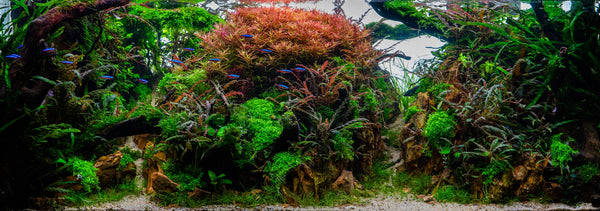
Join Us
Join our Facebook group and benefit from the knowledge of
Australia’s largest community of planted aquarium enthusiasts!
